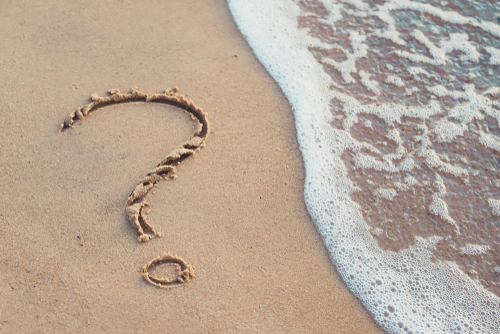What Happens When There’s No More Sand?
A very visible impact of climate change on the North Shore of Oahu.
Dave Brubeck’s “Unsquare Dance” taps in 7/4 time in the background. Rain schizophrenically falls. The ocean is gray and whitecapped. It’s one of those timeless down days on the North Shore of Oahu.
Everyone seems to vanish on days like this. North Shore surfers are like the opposite of vampires, only coming out in the sunshine. Hunkered down in big-wave legend Ken Bradshaw’s rental bungalow west of Sunset Beach, it’s impossible not to notice that the beach is a fraction of what it once was … Much of the golden sand is gone.
The broad beach that once stretched from Sunset west to Keiki is much smaller than it was just a few years ago. Houses are in danger of being swallowed by the sea, and residents have constructed rudimentary barriers in an attempt to save their property. Nevertheless, millions and millions of dollars of prime, oceanfront surf real estate is in peril. I’ve been coming to this part of Hawaii for 20 years and the transformation is radical.
“This is something of a whole different magnitude,” ssays Dolan Eversole, a coastal geologist for the University of Hawaii Sea Grant program working on the situation at Sunset. “Nobody has ever seen erosion quite like this.”
Tragic as it is, back home in San Clemente, California, the story is much the same. From Dana Point south to San Onofre, another buzzing hive of surf activity, the ocean has gobbled up massive amounts of sand, leaving houses, roads and train tracks in peril. The San Onofre Nuclear Generating station sits closer than ever to the corrosive salt water.
The reasons both surf epicenters are experiencing such a profound problem with erosion is both complex and simple. The overarching answer is climate change. Weather and swell patterns have changed.
Just the other night, on a walk up the beach at Sunset, I ran into a long-time North Shore resident who was one of the first to windsurf in the area in 1970. He noted how the trade winds have changed. They used to see an average of 300 days a year of trades. That number is now down to 200.
Earlier this year, ASN caught up with famed surf explorer and boat captain Martin Daly. He’s been spending a lot of time in the South Pacific’s Marshall Islands and pointed out that the elders on some of the more remote atolls have talked about a noticeable decline in trade winds, and at times, the winds have reversed the direction they are blowing.
Meanwhile, sand flow is a complex, fluid, inexact science. The North Shore Community Land Trust has teamed up with the World Surf League’s environmental organization, PURE, the Honolulu Department of Parks and Recreation, the Hawaii Department of Land and Natural Resources, the University of Hawaii Sea Grant College Program and a handful of other organizations and community members to develop a pilot program to see if they can slow down the erosion and, hopefully, restore the shore at Sunset Beach (or Paumalū in native Hawaiian). Sunset is literally the canary in the coal mine at this point.
Last September, over 100 volunteers showed up at Sunset to plant over 4,000 native coast plants, build a temporary fence the protect the young vegetation and walkways onto the beach to help reduce the impact of foot traffic. The fencing was constructed from repurposed invasive ironwood trees that were removed from Kahuku Point (Kalaeokaunaʻoa in Hawaiian).
When it comes to the impacts of climate change on surfing, we’re quick to talk about sea-level rise or rising water temps and coral reefs, but the loss of sand in places like the North Shore in Hawaii, and Orange County in California, are very real and it’s happening right before our eyes.
This winter I had the opportunity to spend a day with a number of different groups that are working towards making the North Shore a more sustainable place to live and visit. Groups like Sustainable Coastlines Hawaii are doing incredible work addressing the problem of plastics in the ocean, as well as diverting the waste generated from the Triple Crown of Surfing from landfills to recycling centers and compost piles. When they started working with the Triple Crown less than 30 percent of waste was diverted. Several years later that number stands close to 70 percent.
Places like the Waihuena Farm are building an organic connection to the community and the food they eat. Obviously, Oahu is an island, so if the ships stopped bringing food to port, it’s believed that in less than two weeks’ time food stocks would be diminished to the point where island-wide rioting would break out. Places like the Waihuena Farm are trying to prove that it is, in fact, possible and much healthier to produce food locally.
“The mountains, valleys, rivers and ocean are all connected,” explained environmental advocate, writer and renowned spear fisherwoman Kimi Werner, who joined the sustainability day that was hosted by Triple Crown sponsor Vans.
This is the first winter that the new native vegetation at Sunset Beach will have to endure. If it can survive, the hope is that it will help hold the sand in place and create dunes that will, in essence, save Sunset Beach.
For almost three-quarters of a century now, surfers have been tempting fate at Sunset. From pioneers like Lorrin “Whitey” Harrison and Gene “Tarzan” Smith, who first rode the break in the late 1930s (sans fins on their boards), to the iconic Hawaiian waterman Eddie Aikau, to today’s current crop of talent, Sunset’s forever been considered one of wave-riding’s ultimate proving grounds. We’re now in a fight for its very survival.

